[ZX Spectrum, Imagine Software]

I have been covering quite a few ZX Spectrum games so far, but Imagine Software’s Stonkers is probably the first one to have made a major mark in the history of video games. Stonkers is in most lists of “first RTS”. I argued on this blog that Cytron Masters came before and was indisputably a RTS, but Stonkers still has a claim for the second position ; and in some ways it is more recognizable as a RTS than Cytron Masters was. You will be the judge.
Stonkers opens with a view of the map of the battlefield, with 4 areas of interest in purple :
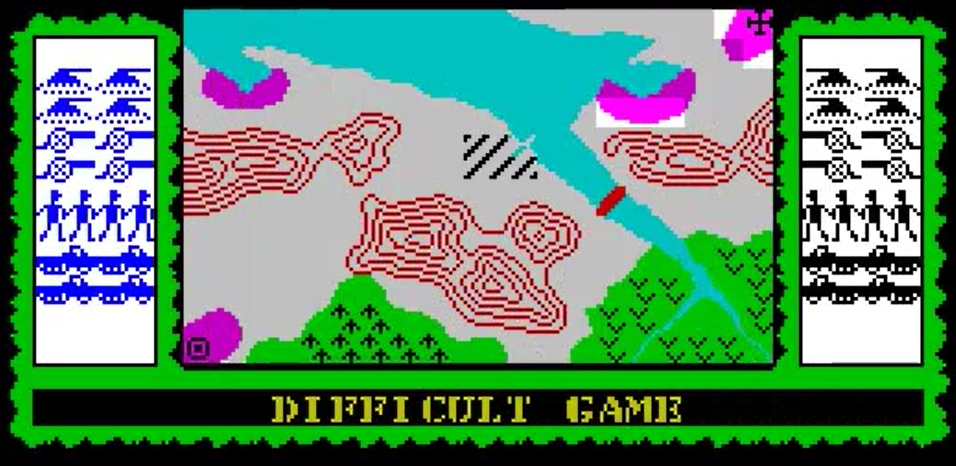
- The HQ areas : mine in the top-right corner of the map, the one belonging to the computer in the bottom left corner. Having unopposed units in the HQ of the other player wins the game.
- The ports, mine next to my HQ, the one belonging to the computer in the top-left corner. That’s where supplies are unloaded by ships that appear at the top of the map and slowly make their way to the docks.
The map is also divided by a river crossed by one bridge. Touching the water is instant death, so the bridge is the only way to cross ; there is no other passage even in the bottom-right corner of the map.
Quite impressively for a Spectrum game (or really any 1983 game), Stonkers allows you to zoom on any area of the map perfectly smoothly. I start my checking my artillery and tanks deployed around the HQ area :

Given the enemy has a bridge to cross, I don’t need to keep my units in the HQ area, and I move my tanks and artillery to the port by selecting them and then drawing their paths with the pointer.
In my port area, I find 4 infantry, my 4 supply trucks and a docked ship. When a supply truck is sent to a unit, the truck disappears and the unit’s supply is restored to 99. If the ship is docked, the supply unit is then immediately regenerated. As all units start at 50 supply, I immediately resupply all my infantry.

When the tanks and artillery arrive at the port, the ship has already left, so I can only resupply half of them. The rest have to wait for the ship to come back.
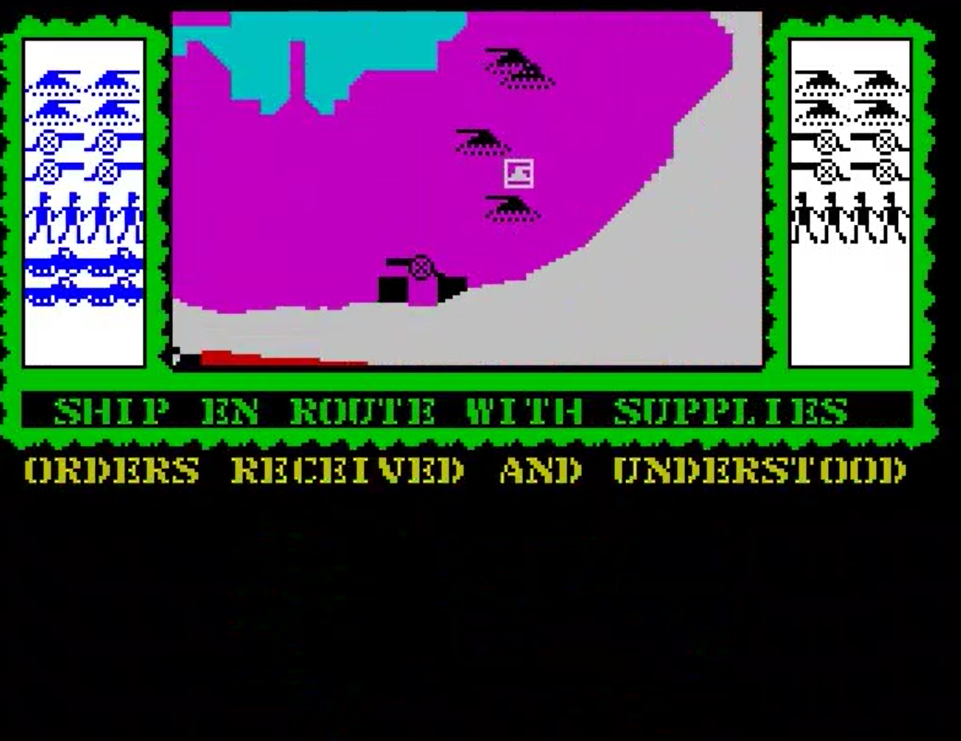
Meanwhile, I deploy my units around the bridge. I even cross with one tank. No sign of the enemy.
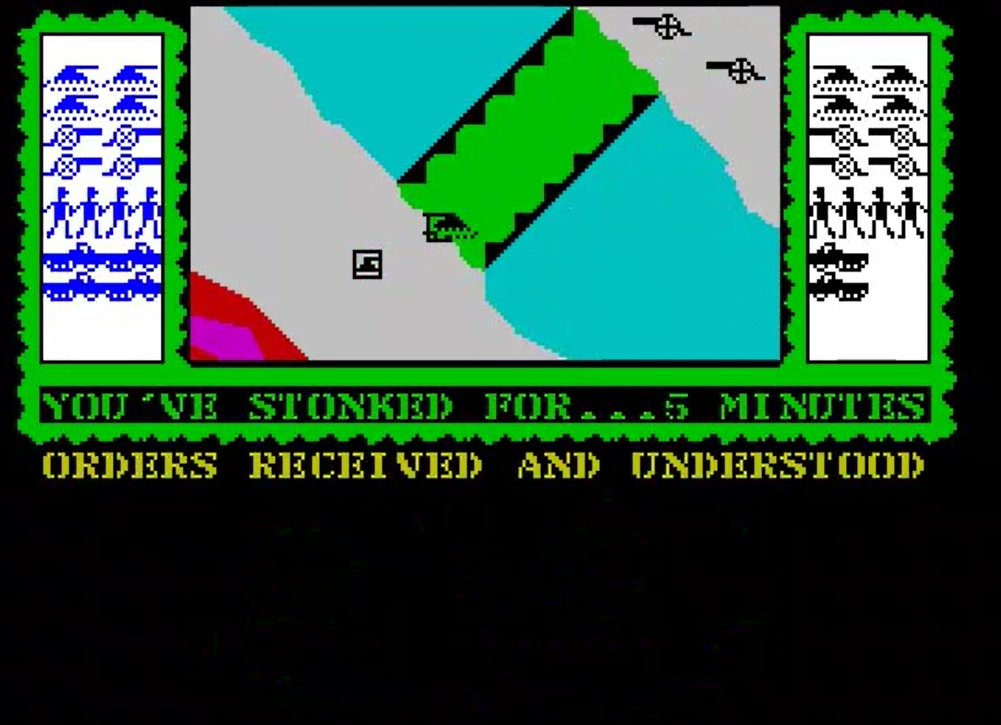
Once I’ve resupplied all my units with another shipment of supplies, I cross the bridge with all my tanks and artillery, splitting the weaker infantry between my port (3 units) and my HQ (1 unit). One tank is sent alone to try to sneak into the enemy port :

Half-way to the enemy port, my tank finally encounters an enemy unit, and the first combat starts. In Stonkers, there is no ranged attack. Instead, units “fight” by overlapping. It is possible to disengage, but I should win this as, according to the manual, tanks beat artillery.

I am proven wrong : my tank is destroyed. I don’t have much time to lament about it, this is a real-time game and I need to zoom on the bridge to manage an all-out attack by the computer !
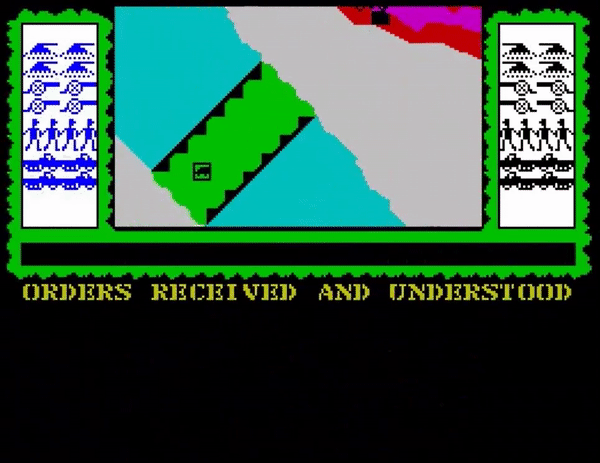
I order my tanks and artillery to overlap with the enemy forces, which is one of the least intuitive orders I have ever given. Good, proper artillery should stay in the back, raining death on the enemy, not give them death kisses. I soon destroy an enemy tank, as it disappears from the list on the left and leaves a nice skull on the battlefield.

The battle carries on. According to the manual, tanks generally beat artillery and artillery beats infantry but in practice melees soon turn into chromatic chaos and it is impossible to optimize ; I am not even sure which units are mine. The last time combat confused me as much was when I was playing Ants!!!

Both sides lose more units, and I notice at least two enemy units sneaking behind the melee and crossing the bridge ! I also discover that I just lost some infantry that was supposed to be on the safe side of the bridge !

Jumping to the port, I discover I have only two units of infantry left out of three !

I focus all my attention on this area. Even though my two infantry units are attacked by 3 enemy units, they come one after the other, curiatii-style and presumably not fully supplied either. I destroy them one after the other, with my trucks constantly providing supplies :

When I can finally jump back to the situation on the bridge, I realize I had the upper hand there too, possibly because the computer sent some of its best units against my port. I also notice that my units are running out of supply, but luckily I can easily intercept enemy supply trucks and use their supplies to give my units a second lease on life !

And then my resupplied units jump back into the fray :

The last enemy unit finally dies on the pile of corpses and destroyed vehicles, and I win the game :

It took me around 30 minutes of significant micro-management to achieve this victory, but it was only my third attempt, and my first one at the “difficult” level.
Ratings & Review
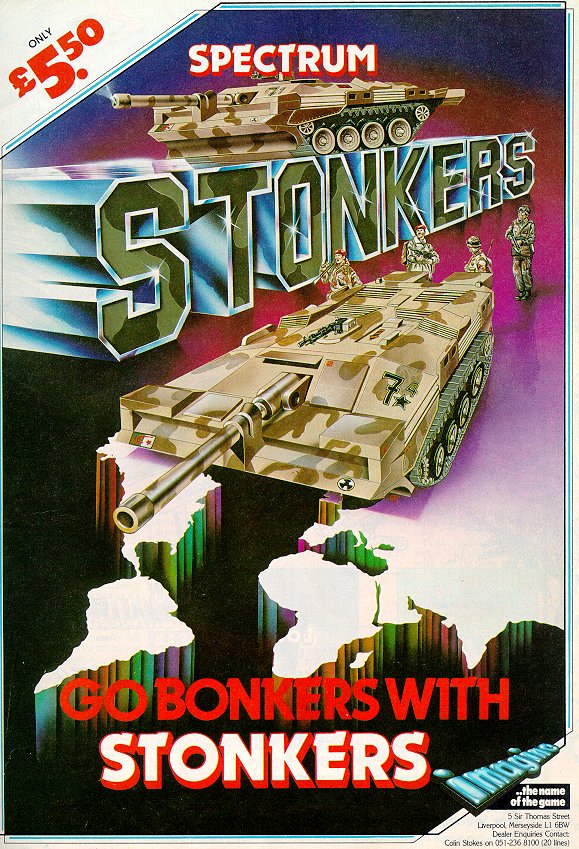
Stonkers, by John Gibson, published Imagine Software, UK
First release : November 1983 on ZX Spectrum according to press releases
Total time tested : One hour
Average duration of a game : Less than 30 minutes
Complexity: Easy (1/5)
Final Rating : Flawed and obsolete
Ranking at the time of review : 53/102
Summary
As one of the first RTS in history, Stonkers was technically one-of-a-kind in 1983, with innovative features like zooming and drag & drop movements that would not only become standard several years later. Still, its lack of stability and shallow gameplay failed to impress even at its release, and time did not help with the latter.
Stonkers is by far the most famous game by Imagine Software, one of the many British video games that flourished in the early 80s and usually soon disappeared after a lepidopteran lifespan. Yet, unlike so many other forgotten companies, the short-lived Imagine Software ended up having such an influence on the industry that the Digital Antiquarian allocated no fewer than 3 articles to it – honestly, you should read them – they are some of his best.
Long story short, Imagine Software was founded in Liverpool in 1982 by Mark Butler and Dave Lawson, soon joined by Bruce Everiss. Everiss, who had earlier in 1978 created the first computer retail shop in the UK, was bringing his management and marketing skills, whereas Lawson, a precocious and self-taught coder of around 20 years at that time, would program the games. The story does not say what Butler brought to the table. Thanks to the quality of Lawson’s early arcade games, which lacked in originality but more than compensated in production value, and thanks even more to Everiss’s incredible advertising acumen, Imagine Software became one of the leading British video game companies in late 1982 and early 1983. This made the co-founders incredibly wealthy (or so they claimed) and attracted a flock of programmers to their office, among which was John Gibson.

At 36, John Gibson was older than the three founders. He soon coded his two first games for Imagine : Zzoom and Molar Maul, which were, depending on who you trust, either “best-sellers” or run-of-the-mill arcade games. In an interview with Retrogamer, Gibson explains that most of what made Stonkers memorable came from Lawson, including the name, “stonk” apparently being British military slang for a massive bombardment. Gibson takes credit for two features : the first one is the supply system, because Lawson had asked him to make sure the game had “a sense of urgency so that if you took too long, pondered too much over your next move, you’ll get beat”, and having to manage the supply trucks always gave the player something to do. The second feature Gibson claims as his own is the AI, inspired by his reading of an article by Chris Crawford on the AI of Eastern Front.
Gibson also claims that the game was developed in two months not on a Spectrum but on a Sage IV, and then barely playtested, shipping with some major bugs, including a systematic crash when you approach the bridge a certain way. Because by early 1984 Imagine Software was running out of cash (it would be bankrupt by June 1984), its answer to complaints was to blame a faulty batch of tapes and resend a copy – which of course would have the same issue. The crashes were never officially fixed, though the version I played did not seem to have issues, possibly thanks to the emulator.

As a final note before rating, I had a bit of a dating issue with Stonkers. My practice is to date the game through the earliest mention I can find of the game existing in an ad, catalogue or article. For this purpose, I ignore the fact that the game could have been distributed earlier directly in shops, or that a game could be advertised before being effectively available. When the first mention is found in a magazine, I use the date of the magazine, even though the effective availability of the magazine is often earlier (eg the “June” issue of a magazine often hits the shelves in May).
For Stonkers, the first mention of the game is in the January 1984 issue of Computer + Video Game magazines, in which what’s clearly the copy of a press release announces that the game is available “in late November”. It can only be late November 1983, so I considered the game a late 1983 release.
A. Immersion
Poor. I am not convinced by tanks and artillery attacking in melee.
B. UI, Clarity of rules and outcome
Average. Stonkers mixes the best and the worst. The best is of course the smooth zooming, which is technically not a zoom but a trick that Gibson explained thus to Retrogamer : “it doesn’t actually zoom as there were two maps, the detailed one and a zoomed out one, so it was just a case of changing maps.” In addition to that, Stonkers is the smoothest game so far for moving units in real time.
As for the issues, they should be obvious from the AAR : large combats are impossible to read and picking up individual units in that circumstance is a challenge, especially since the game allows you to pick up destroyed units. The game does not give you any information about enemy units either, and even checking the situation of your own units is too slow given the nature of the game.
C. Systems
Very poor. Officially, the game has different terrain effects and a unit meta (tanks beat artillery, artillery beats infantry). In practice, all my games ended with a massive overlap melee where all units were on top of each other. The game would have been massively superior if it had included ranged attacks and different capabilities depending on the units, and then maybe a factory and a way to collect resources, but then it would have been called Dune II I suppose.
D. Scenario design & balancing
Terrible. There is only one map with an obvious bottleneck where the decisive battle will happen. Stonkers has two levels of difficulty and is single-player only, even though people seem to remember otherwise.
E. Did I make interesting decisions
Not really.
F. Final rating.
Flawed and obsolete. Stonkers was technically innovative in 1983, but its gameplay was always shallow, though not actively unpleasant to play.
Contemporary Reviews
Nowadays, Stonkers has achieved meme status in the community of Spectrum retrogamers, and even people who never owned a Spectrum may have heard its name as one of the first RTS. Yet, its genre seems to have confused the first reviewers, more used to either real-time arcade games or turn-based strategy games. Two early reviews from February 1984 are I believe representative :
- Home Computing Weekly gave the game 40% in playability, calling the game “disappointing” and explaining that the game has “too little action for arcaders [and] not enough information for strategists”,
- Computer & Video Games gave the game only 5/10 in playability, complaining about the game’s difficulty (” The whole idea is pretty complicated and I spent the best part of a whole day studying the instructions in front of a Spectrum. For all my gallant efforts, I succeeded in drowning my entire regiment in the sea.”). Still, “if you’re fed up with zapping everything in sight […] then this will be good value”.
But soon enough, reviewers realized they were witnessing a technical feat and the birth of a new genre, and the reviews mellowed, even though they were never universally positive. The first positive review came from an anonymous reviewer of Crash (March 1984), who stated excitingly that the game “barely [leaves] you with any time left to think”. Another reviewer in the same issue explains that Stonkers is the best wargame they have played because “it keeps you on the go constantly without having to wait while the enemy “has his turn”. The magazine Big K compares Stonkers to the works of “American designer Chris Crawford” in April 1984 and similarly, one month later Micro Adventurer compared it to Eastern Front. As for Sinclair User, it published in April 1984 an article on the birth of the “arcade-strategy” genre, calling Stonkers a “prime example of that type of game”, concluding “The insurgence of that type of program means that the customer has two types of game in one and [it]takes the games industry one step forward”.
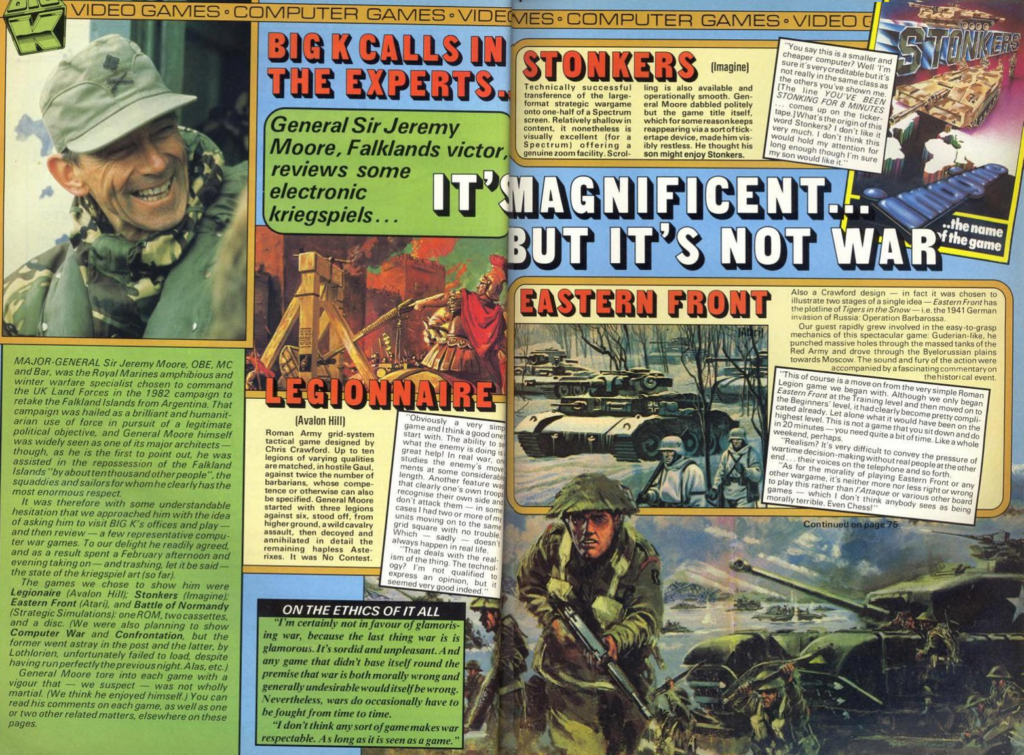
Amusingly, Crash – which published the first decidedly positive review of Stonkers – remembered describing it only as “medium impressive” when commenting on the result of their “best wargame of 1984” reader poll in January 1985 : Stonkers had ranked first with 25% of the vote, beating both Lords of Midnight and Rebelstar Raiders. More than one year later in May 1986, they lamented in another article that Stonkers “never really had the credit it deserved“. As Crash hypothesized, the lack of credit may come from the utter lack of stability of the game. Indeed, browsing through the archives, most of the (non-ads) mentions of Stonkers I found are about its many crashes : letters from readers complaining they could never finish a session or articles lambasting the poor quality control in video gaming using Stonkers as an example. It is forgotten now, but it must have been a harrowing experience to play Stonkers in historical conditions.
In any case, Stonkers is part of what I consider the canonical list of pre-Dune II RTS, a list that does not seem to have changed in 2023. Imagine Software disappeared a few months after the release of Stonkers, and while Gibson continued his career in videogames, he made no other game within the scope of this blog. We are also done with the Spectrum games from 1983 and I have only a handful of minor games (except Carrier Force) left to cover before the end of 1983.